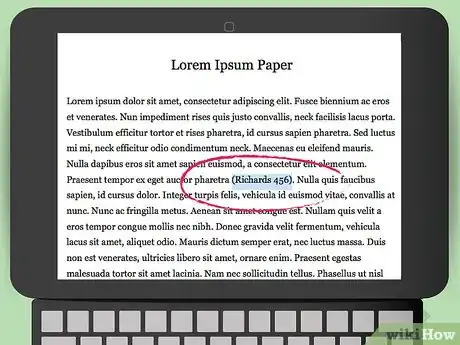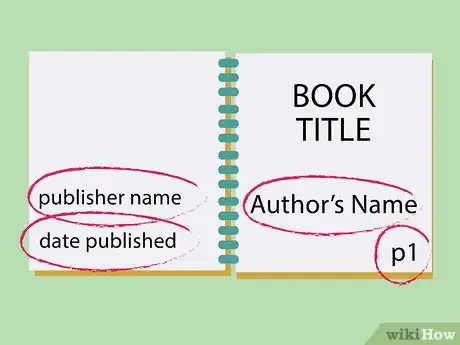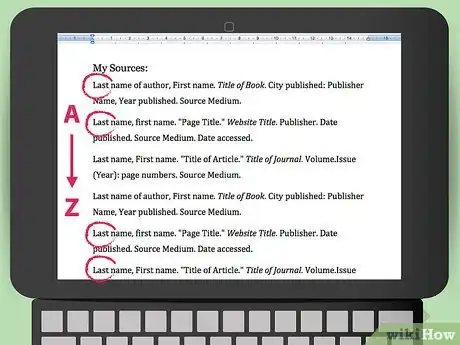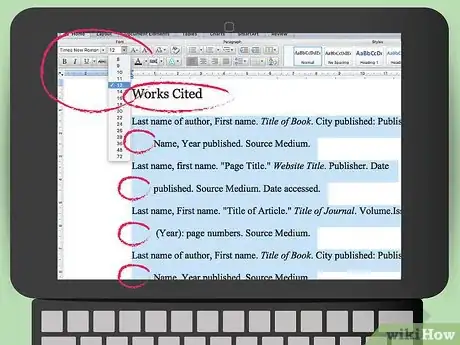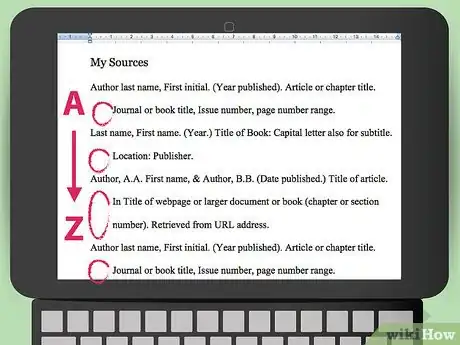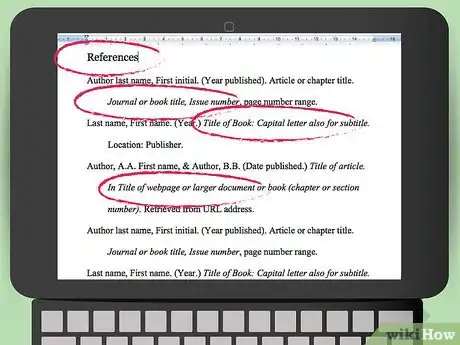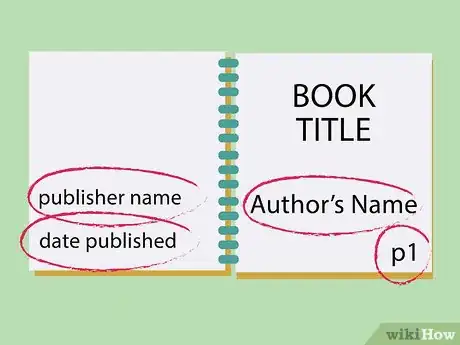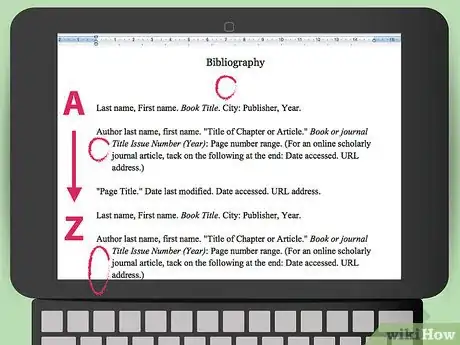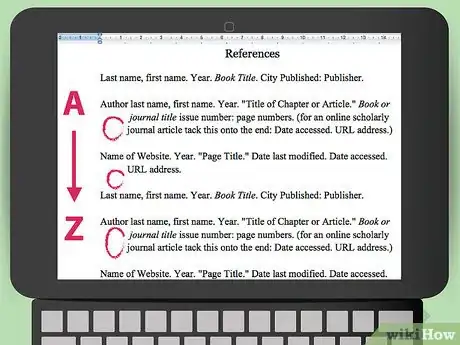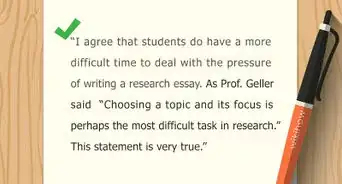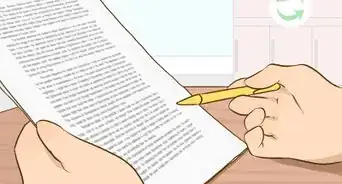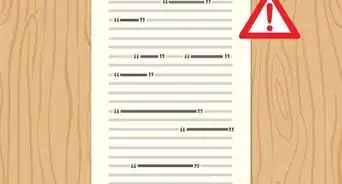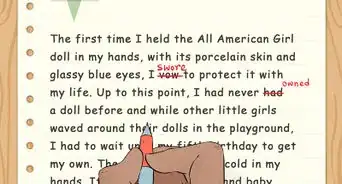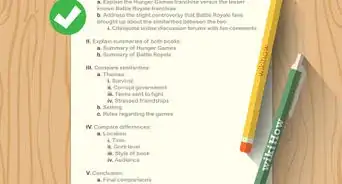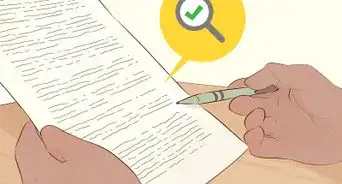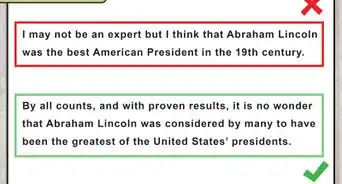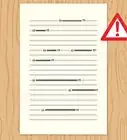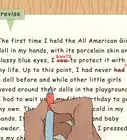This article was co-authored by Alexander Peterman, MA. Alexander Peterman is a Private Tutor in Florida. He received his MA in Education from the University of Florida in 2017.
There are 14 references cited in this article, which can be found at the bottom of the page.
This article has been viewed 318,167 times.
When you begin writing a research essay, you must take into account the format of your writing and reference pages. There are several reference styles that may be assigned to you, including MLA (Modern Language Association), APA (American Psychological Association), and Chicago. Each one has its own set of rules. There's no need to familiarize yourself with all 3 unless you have to, but you do need to learn at least one if you’re in any field involving academic writing. Here are summaries of each style to help you start your essay on the right track.
Steps
Using MLA
-
1Cite while you write. MLA makes use of short in-text citations inside parentheses, compiling them in an alphabetical Works Cited list at the end of the document. While you're composing an essay, it's important to include where you get certain information in order to avoid plagiarism (passing another's knowledge as your own).[1]
- You will need a citation directly after every sentence (or group of sentences if you're citing the same source in multiple consecutive sentences) containing information you didn't think of yourself. These include: paraphrases, facts, statistics, quotes, and examples.
- An in-text citation using MLA will simply have the author last name (or title if no author) followed by the page number. No comma between author and page number. For example: (Richards 456) Richards is the author last name, and 456 is the page number.
- If you have an author name (or title, if no author) but no page number, simply use author last name (or title).
-
2Gather information. When you do research using MLA style of citation, you need to gather specific pieces of information for each citation. You will need things like author’s name, publisher, date published, and page numbers.
- The easiest way to keep track of MLA citations while doing research is to copy and paste copyright information into a word processing document as you go, or to write it down in a notebook.
- Things to include for any source are author(s), date published, publisher, page number, volume and issue number, website, date accessed, anything that appears on the copyright page or indicates how to find it again.[2]
Advertisement -
3Organize the sources. When you have completed your writing and are preparing to turn it in or publish it, you must alphabetize your citations in a Works Cited page. This page should be the last of the document.[3]
- As an example, the format for a standard book citation using MLA style is as follows: Last name of author, First name. Title of Book. City published: Publisher Name, Year published. Source Medium.
- An MLA website citation looks like the following. If there's no author listed, begin citation with the name of the page: Last name, first name. "Page Title." Website Title. Publisher. Date published. Source Medium. Date accessed.
- An MLA scholarly article citation looks like the following: Last name, First name. "Title of Article." Title of Journal. Volume.Issue (Year): page numbers. Source Medium.
- Write the title of the main work (book, magazine, journal, website, etc.) in italics, or underline if you’re writing references by hand.
- Chapter or article titles should be in quotation marks.
-
4Alphabetize the list. Place your list of references in order alphabetically by the authors' last names.[4]
- If there is no author listed, as is common on websites, simply skip the author’s name and begin the entry with the title of the work.
- Alphabetize by the first letter that appears in the entry, whether it has an author name or not.
-
5Format the Works Cited page. Double-space your document, and title this list of citations "Works Cited."[5]
- The formatting should be in Times New Roman font, size 12, with “Works Cited” centered at the top of a new page.
- Each entry should have hanging indent, meaning all lines below the first line are indented by half an inch.
- Make sure there is a period after each section of the citations. A period should always end the citation.
Using APA
-
1Cite while you write. APA requires citations inside parentheses in the text of an essay, compiling them in an alphabetical References list at the end of a document. While you're writing an essay, it's important to cite information so that you avoid plagiarism (a form of cheating).[6]
- Place a parenthetical citation at the end of every sentence (or group of sentences if you're using the same source for multiple consecutive sentences) containing information you didn't know before doing research.
- An in-text citation using APA will simply have the author last name (or title if no author) followed by the year it was published. No comma between name and year. For example: (Richards 2005) Richards is the author last name, and 2005 is the year.
- If you have an author name (or title if no author) but no page number, simply use author last name (or title). This is common when citing websites.
- APA document formatting is very important. APA papers are divided up into 4 sections: the title page, the abstract, the main body, and the references page. The citations of a research paper using APA appear in the References section, the last portion of an APA document.[7]
-
2Gather information. Write down copyright information as you go for every piece of research you glean from. Write it down for every source you look at with a note to jog your memory--you'll be surprised how many ideas you start to paraphrase, unable to remember where you got that idea.
- To form APA reference page citations, you will need such information as author name(s), date published, website URL, date you accessed the website, title of work, and so on.[8]
-
3Organize the list. The list of references should be alphabetized and set to hanging indent, just like MLA style format.[9]
- For example, the format for an APA reference of a scholarly journal article is as follows: Author last name, First initial. (Year published). Article or chapter title. Journal or book title, Issue number, page number range.[10]
- The format for an APA book reference looks like: Last name, First name. (Year.) Title of Book: Capital letter also for subtitle. Location: Publisher.
- The format for an APA website reference looks like: Author, A.A. First name, & Author, B.B. (Date published.) Title of article. In Title of webpage or larger document or book (chapter or section number). Retrieved from URL address
-
4Format the page. Double-space your document, and title the references page "References" at the top-center of the page. Put the page number all the way to the right, and a shortened version of the title of your paper all the way to the left in all capital letters.[11]
- Capitalize the author's last name and first initial, followed by a period.
- Only capitalize the first word of a journal article title, unless the title contains a proper noun (called sentence case). Titles of books should preserve the published capitalization.
- Capitalize the city of publication, and use correct state abbreviations for states. Also capitalize the name of the publisher and end the reference with a period.
- The title of larger works, whether a book, journal, website, or magazine, is in italics (or underlined if handwriting), as is the issue number that appears right after the title. Titles for shorter works like articles and chapters should not have any indicative punctuation in an APA entry.[12]
- A period should end all citations.
Using Chicago Manual of Style
-
1Cite while you write. CMOS or Chicago utilizes two different of reference styles: Notes and Bibliography, and Author Date. Your in-text citation depends on which style of citation you’re using.[13]
- For Notes and Bibliography, you will use a superscript at the instance of each quote in the text with a corresponding footnote at the end of the page. All footnotes are compiled into endnotes at the end of the work, on the bibliography page.[14]
- For Author Date, you will use parenthetical in-text citations that include author last name and year published, using no punctuation between name and year. The full version of each parenthetical citation is listed alphabetically on the references page. For example: (Simon 2011) Simon is the author last name, and 2011 is the year.
- You will need a citation directly after every sentence (or group of sentences if you're using the same source for multiple consecutive sentences) containing information you didn't think of yourself. These include: paraphrases, facts, statistics, quotes, and examples.
-
2Gather information. As you do research for your essay, take note of all bibliographic information that you see. This means title, author, publication, year, volume and issue number, location of publication, website, even the date you access the material if it’s online.
- If using a book, write down all pertinent information found on the copyright page, including the name of the publisher and the city and year of publication.
- For other sources, look for this information near the title of the piece you’re looking at. Publication date is often at the bottom of webpages.
-
3Use Notes and Bibliography if instructed. The Notes and Bibliography (NB) method is preferred by scholars in the humanities (literature, history, arts). NB is conducive to recording a wide range of sources in detail, which the Author Date system doesn't allow for.[15]
- Title your references page “Bibliography” centered at the top of the page. Leave 2 blank lines between this title and the first entry, and one blank line between entries.
- Notes and Bibliography style uses footnotes for page endings and endnotes for chapter endings. The bibliography page will be an alphabetized list of all sources in hanging indent.
- An example format for a book is as follows: Last name, First name. Book Title. City: Publisher, Year.
- An example format for a chapter in a print scholarly journal is as follows: Author last name, first name. "Title of Chapter or Article." Book or journal Title Issue Number (Year): Page number range. (For an online scholarly journal article, tack on the following at the end: Date accessed. URL address.)
- An example format for a website is as follows: Name of Website. "Page Title." Date last modified. Date accessed. URL address.
- When there is no known author, the entry should begin with the title of the document, whether it's a webpage, chapter, article, and so on.
- When there are multiple authors, the first listed author appears last name, first name, so that the citation is alphabetized by this author's last name. Subsequent authors are listed by first name, like this: Alcott, Louisa May, Charles Dickens, and Elizabeth Gaskell.
- Always end a citation with a period.
-
4Use Author Date if instructed. The Author Date style is preferred by those in the sciences, i.e. physical, natural, and social sciences. Author Date is a more concise style of documentation.[16]
- When using Author Date style, title your references page “References” centered at the top of the page. Leave 2 blank lines between this title and the first entry, and 1 blank line between entries.
- Author Date style bibliographies should be organized alphabetically by last name (or by title if no author) in hanging indent.
- An example format for a book is as follows: Last name, first name. Year. Book Title. City Published: Publisher.
- An example format for a chapter in a print scholarly journal is as follows: Author last name, first name. Year. "Title of Chapter or Article." Book or journal title issue number: page numbers. (for an online scholarly journal article tack this onto the end: Date accessed. URL address.)
- An example format for a website is as follows: Name of Website. Year. "Page Title." Date last modified. Date accessed. URL address.
Expert Q&A
Did you know you can get expert answers for this article?
Unlock expert answers by supporting wikiHow
-
QuestionShould I categorize my references into books, websites, journals etc.and divide them?
 Alexander Peterman, MAAlexander Peterman is a Private Tutor in Florida. He received his MA in Education from the University of Florida in 2017.
Alexander Peterman, MAAlexander Peterman is a Private Tutor in Florida. He received his MA in Education from the University of Florida in 2017.
Test Prep Tutor No, that is not necessary. All of your sources should be listed in alphabetical order, using the authors' last name. If there is no author or the author's name is missing, the title of the work will come first in the citation and you can use the title to organize the source into the list. This is the case for all of the "Works Cited" pages for the academic writing styles referred to in this article.
No, that is not necessary. All of your sources should be listed in alphabetical order, using the authors' last name. If there is no author or the author's name is missing, the title of the work will come first in the citation and you can use the title to organize the source into the list. This is the case for all of the "Works Cited" pages for the academic writing styles referred to in this article. -
QuestionWhere can I find an example of a reference paper?
 Community AnswerYou can search on Google for "reference paper examples." That should provide you with plenty of results to browse through.
Community AnswerYou can search on Google for "reference paper examples." That should provide you with plenty of results to browse through.
Warnings
- This article only lists how to cite research for each style manual. Each style has its own instructions for setting up the format of the essay, including heading, spacing, margins, font, and so on.⧼thumbs_response⧽
References
- ↑ https://owl.purdue.edu/owl/research_and_citation/mla_style/mla_formatting_and_style_guide/mla_in_text_citations_the_basics.html
- ↑ https://owl.purdue.edu/owl/research_and_citation/mla_style/mla_formatting_and_style_guide/mla_in_text_citations_the_basics.html
- ↑ https://owl.purdue.edu/owl/research_and_citation/mla_style/mla_formatting_and_style_guide/mla_formatting_and_style_guide.html
- ↑ https://owl.purdue.edu/owl/research_and_citation/mla_style/mla_formatting_and_style_guide/mla_works_cited_page_books.html
- ↑ https://owl.purdue.edu/owl/research_and_citation/mla_style/mla_formatting_and_style_guide/mla_formatting_and_style_guide.html
- ↑ https://owl.purdue.edu/owl/research_and_citation/apa_style/apa_formatting_and_style_guide/in_text_citations_author_authors.html
- ↑ https://owl.english.purdue.edu/owl/resource/560/01/
- ↑ https://owl.purdue.edu/owl/research_and_citation/apa_style/apa_formatting_and_style_guide/reference_list_electronic_sources.html
- ↑ https://libguides.jcu.edu.au/apa/reference-list
- ↑ https://owl.purdue.edu/owl/research_and_citation/apa_style/apa_formatting_and_style_guide/reference_list_author_authors.html
- ↑ https://owl.purdue.edu/owl/research_and_citation/apa_style/apa_formatting_and_style_guide/reference_list_basic_rules.html
- ↑ https://owl.purdue.edu/owl/research_and_citation/apa_style/apa_formatting_and_style_guide/reference_list_basic_rules.html
- ↑ https://www.chicagomanualofstyle.org/tools_citationguide.html
- ↑ https://owl.purdue.edu/owl/research_and_citation/chicago_manual_17th_edition/cmos_formatting_and_style_guide/chicago_manual_of_style_17th_edition.html
- ↑ http://guides.nyu.edu/c.php?g=276562&p=1844734
- ↑ https://www.chicagomanualofstyle.org/tools_citationguide.html
- ↑ http://endnote.com
- ↑ https://www.zotero.org
About This Article
To reference an essay using MLA style, add a citation after any information you found through a source, like facts or quotes. When citing the reference, include the author’s name and the page number you pulled the information from in parenthesis, like “(Richards 456).” Once you’ve finished your essay, add a Words Cited page with all of the information you used to research your essay, like books or articles. To create a Works Cited page, list the sources in alphabetical order using the author’s last name, and include additional information, like year published and the medium. For more tips from our Writing reviewer, like how to reference an essay using APA style, read on!
